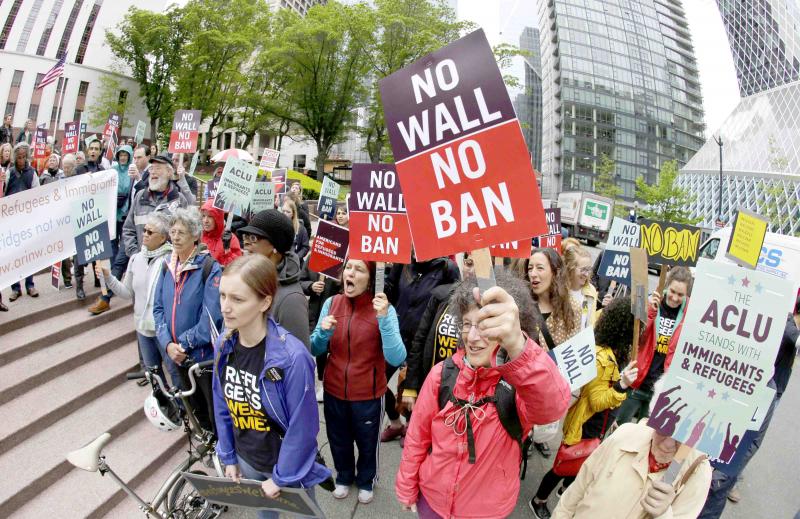Trump’s invisible wall is not just for Muslims
The virtual wall takes the United States back to a century ago, when being white was key to acquiring US citizenship.

Emerging pattern. File picture shows protesters taking part in a demonstration against US President Donald Trump’s travel ban outside a federal courthouse in Seattle. (AP)
The battle to replace Donald Trump in the White House got properly under way with the Democratic Party primary election in New Hampshire, so it’s worth examining the state of Trump’s signature campaign promise from 2016: the wall.
How’s that been going?
Well, the wall is up — virtually — and is taking over many more aspects of American public discourse than originally proposed. Illegal immigration through the US-Mexico border, Trump’s alleged justification for building a wall, continues to fall.
However, the US president continues to throw up bureaucratic barriers even to legal entry and immigration. The number of refugee admissions to the United States fell to the lowest level on record last year, fewer foreign students and tourists were going to the United States and fewer green cards were being issued, the US State Department said.
By some estimates, Trump’s vow to bar all Muslims from entering the United States has taken effect in the past two years in the form of varying levels of travel and immigration restrictions on an estimated 7% of the world’s population. More than 135 million people in seven, mainly Muslim countries have been affected.
The Migration Policy Institute, a Washington think-tank, said the number of permanent visas given every month in 2017-18 to nationals of Iran, Libya, Somalia, Syria and Yemen fell 72%.
In the first week of February, Trump extended travel and immigration restrictions to another six countries. As of February 22, people from Kyrgyzstan, Myanmar, Eritrea, Nigeria, Sudan and Tanzania will no longer be able to permanently migrate to the United States but are allowed short-term travel.
This, too, is a “Muslim ban” of sorts. Except for Myanmar, where Muslims account for 4% of the population, Muslims are more than one-quarter of the population of the countries newly targeted by Trump. Tanzania, for instance, is 30% Muslim and Kyrgyzstan is 86%.
A pattern is emerging from Trump’s travel and immigration restrictions. The target countries either have dark-skinned people or large numbers of Muslims or both. As US Senator Kamala Harris, a Democrat from California, recently posted on Twitter: “Trump’s travel bans have never been rooted in national security — they’re about discriminating against people of colour. They are, without a doubt, rooted in anti-immigrant, white supremacist ideologies.”
Admittedly, the Trump administration’s overall policy betrays a broader hostility to any category of foreigner — legal, illegal or asylum-seeker — seeking to enter the United States but the original targets — Muslims — have been distinct and symbolic and they have always been the foundation of the virtual border wall.
On that foundation have been laid the bricks that constitute the virtual wall. The bricks are a steady stream of administrative decisions. There are orders to bar entry to the United States for certain groups of people from certain countries. There are orders to reduce the annual quota of refugees that America is willing to take.
The administration has made it practically impossible for asylum claims at the US border to have any chance of successful resolution. Brick by brick, the impediments Trump has placed to entry into the United States have had the cumulative effect of an impenetrable if invisible wall.
It is more consequential than the nearly 200km of physical border wall completed by the Trump administration. The virtual barrier will serve as a greater deterrent than the 130km of wall that Trump’s new budget proposal for this fiscal year says he wants to build. And, were Trump to be re-elected in November, it’s almost irrelevant that he finish the full 725km of barriers planned by 2021. The virtual wall would be the more important and the greater deterrent to travel to the United States by Muslims and dark-skinned people.
That’s partly because Trump’s virtual wall suggests to those who live and work in its boundaries a deep and abiding sense of security. It is a false sense, premised on the assumption that the American people are either too stupid or too lazy to notice that their problems do not arise from Muslim and dark-skinned migrants. It is meant to disguise the painful reality that the gains of US economic growth are unevenly distributed, that Trump as president has only aggravated income inequality with his 2017 tax law and that a strong safety net and affordable healthcare remain a distant dream in the world’s richest country.
In their 2016 book, “Framing Immigrants: News Coverage, Public Opinion and Policy,” Chris Haynes, Jennifer Merolla and Karthick Ramakrishnan explored the discourse about immigration in the United States.
They said attitudes towards immigration change when the economy is faring badly or when politicians bring up the issue. Ramakrishnan suggested the politicians are the more influential. By Trump’s own, somewhat disingenuous, account, the US economy is doing very well. So the focus on immigration is clearly based on a darker vision of foreigners as criminals, competitors and a burden on the American state.
The virtual wall takes the United States back to a century ago, when being white was key to acquiring US citizenship and there were barriers to immigration for all but Caucasians and Western Europeans. In the 21st century, though, it merely highlights the growing dissonance between Trump’s America and the country’s founding ideals.
Originally published in The Arab Weekly

